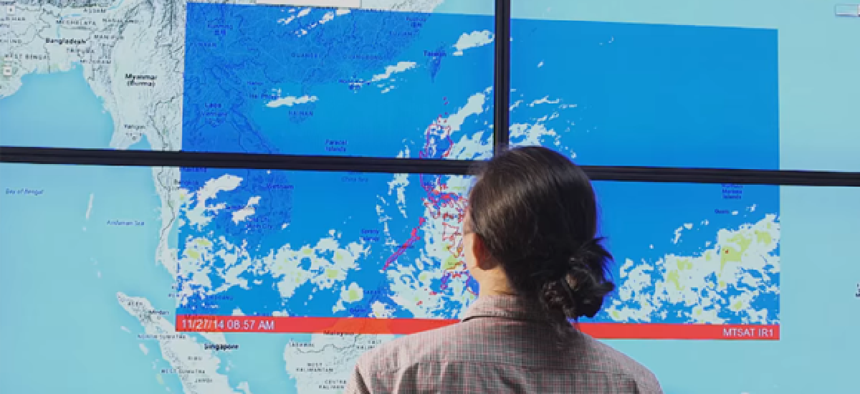How governments really use emerging tech


Connecting state and local government leaders
A number of agencies have been able to leverage innovation to deliver government services more efficiently, create public value and transform lives, a new report says.
Artificial intelligence, blockchain, robotics and virtual reality are at the top of every “hot technology” list, but translating emerging technology into practice is often a heavy lift, especially for government agencies working under budget and regulatory constraints.
A number of agencies, however, have been able to leverage these technologies to not only deliver government services more efficiently, but also “create public value and transform people’s lives.”
A new report described nine categories of innovation and provided global case studies that best illustrate the government’s use of the tech, describing the impact, innovation, readiness, sustainability, scalability and replicability. Some of the case studies:
Artificial intelligence
The Philippines Department of Science and Technology worked with IBM on a new Intelligent Operations Center that includes technology for integrated data visualization, real-time collaborative capabilities, integrated maps, online dashboards, customizable reports, interactive standard operating procedures and analytics. The software, together with the new facility, helps improve city operations and emergency response by centralizing disaster management and recovery. By combining information from disparate sources, emergency managers can have information such as advanced warning for extreme weather events, immediate feedback from first responders, and information on infrastructure conditions. Analytics and scenario planning streamline the government’s disaster response.
Blockchain and distributed ledgers
Estonia’s blockchain technology usage, particularly the country’s eHealth Record, has been used to secure over one million patient healthcare records and digitize medical documents. Health record management requires a high level of confidentiality, so even when using blockchains, healthcare records require facility-level protection (health records must be physically as well as technologically secure), cryptographic signature techniques and other protections. The Estonian eHealth Foundation integrated Guardtime’s KSI blockchain with existing Oracle databases, giving the system indefinite scalability and the ability to detect unauthorized record changes.
Citizen engagement and analytics
Denmark’s health care system features many technology initiatives that leverage data to improve disease prevention, diagnosis and treatment. The Danish system is characterized by its extensive digitization, electronic communications between healthcare providers and systematic use of data. Programs include:
- Telehealth projects and highly computerized hospitals, use virtual endocrinology outpatient clinics that are expected to connect as many as 20,000 patients through video consults
- Near-real-time monitoring of patients with chronic obstructive pulmonary disease
- New assisted-living technology, such as mobile apps and virtual rehabilitation solutions using sensors to monitor and register exercises for independent rehabilitation
- The Prevention of Acute Admissions by TeleHealth program that uses home monitoring, including video consults, to connect elderly residents to healthcare providers, reducing acute admissions.
Other initiatives include hospital patient self-tracking; wireless pumps for cancer patients; and E-Journal, which extracts and compiles information from hospitals’ electronic health records to provide healthcare practitioners with an overview of a patient’s medical record in relation to a hospital visit.
The digitalized system gives citizens and their doctors access to their own medical data from national health registers, electronic health records and pharmacies.
New manufacturing
For nearly ten years the Mayo Clinic has used 3D printing to create life-like models of people’s organs, vascular systems and bones to help with surgery. With 3D printing, the medical team can practice surgery on a replica, reducing the time needed for the surgery and increasing success rates. Initially the 3D printing was used for prostheses. More than 200 professionals at the Mayo Clinic work with 3D technology, and the clinic now teaches courses to train a variety of professionals on how to use 3D printing in healthcare in the United States.
Robotics and space
Singapore is testing self-driving cars as a means to reduce pollution and traffic jams. The country is using software and algorithms from NuTonomy (an MIT-spinoff) for object recognition and artificial intelligence. The software uses deep learning algorithms applied to video data and other machine learning methods. Singapore has started trials with passengers.
Smart platforms
The Seoul Metropolitan Government implemented a new data analytics system to reduce clean water waste from its distribution network that was based on the correlation between leakage points and weather conditions. It also implemented precise flow metering and a real-time multipoint leak noise correlation system that uses highly sensitive sound sensors to collect and analyze leak noises and pinpoint leak locations. The points are digitized and presented in 3D graphs. By using these technologies Seoul has reduced its leaks from 79 percent in 1989 to 2.5 percent in 2014, saved millions of dollars and improved citizens access to clean water.
Virtual world
Stanford University is using Surgical Theater’s virtual reality visualization platform that combines fighter jet flight simulation software with a patient’s anatomy MRI and CIT scans to give patients a VR reconstruction of their anatomy and pathology. By donning an Oculus Rift or HTC Vive VR headset, patients can get a tour of their internal anatomy and see the planned surgical path. The device increases engagement between doctors and patients who gain a better understanding of the safety and benefits of surgical procedures. The technology also assists with professional education and surgery rehearsal capabilities.
The report was produced by the United Arab Emirates Prime Minister’s Office, together with global consulting and technology company Indra. Read the full report here.




